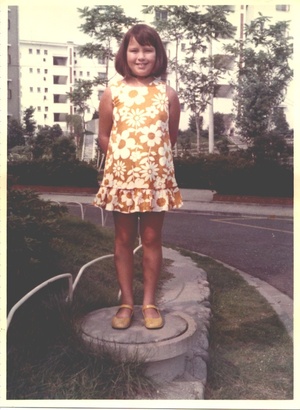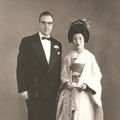Memories that inextricably tie together food, family, and childhood can be some of our most lasting and profound. Such memories and related sensations can surface from the depths at the slightest provocation, and via seemingly random sources. Which brings me to the notion that everything truly is connected, and perhaps increasingly so as we age, memories steep and deepen, and the long ago and faraway take on an otherworldly quality.
One of my favorite films is Whisper of the Heart (Mimi wo Sumaseba 耳をすませば) and I never tire of watching it over and over. A 1995 Japanese anime directed by Kondo Yoshifumi and written by Miyazaki Hayao that’s based on the 1989 manga of the same name by Hiiragi Aoi, it’s hugely nostalgic for me. Set in pre-digital Tokyo (no smartphones! no computers!), the film’s protagonist Shizuko, a 14-year-old middle-school student, is a book nerd who loves writing, much as I did at her age.
But perhaps as significantly for me, Whisper of the Heart resonates, in part, with a cluster of emotional and sensory memories that are encapsulated in a brief chapter of my childhood, when our family of four lived one summer in Osaka’s Senri New Town (Toyonaka City). A danchi, or planned community of large multi-unit apartment buildings, Senri New Town was one of several that were constructed in suburban areas in the ’50s, ’60s, and ’70s to create housing for Japan’s then-increasing population. Shizuko’s family also lives in a danchi, Tama New Town in suburban Tokyo. Utilitarian, small, and crammed with the stuff of daily living, the Tsukishima family’s cozy apartment is brought to life by the sounds and smells of cooking, the flurry of departures and arrivals and domestic tasks, family conversations, and views of the surrounding landscape and shifting skies as seen through Shizuko’s gaze.
Although the danchi apartment my parents sublet in the summer of 1971 isn’t as memorable (I can only vaguely recall it now), what I do remember vividly are my frequent visits, often with my younger brother in tow, to our neighbors’ apartment across the street. The Fujinaga family—Mr. and Mrs. and their two school-aged daughters—inhabited a similarly small apartment. Mrs. Fujinaga was an ordinary Japanese housewife in her 30s. Round-faced, bespectacled, and perpetually cheerful, she bustled about preparing after-school snacks for her girls and their two hafu friends. Mr. Fujinaga was a typical salaryman who announced his homecoming each weekday evening with tadaima!, greeting us children enthusiastically as he shed his suit jacket and trousers in the genkan while Mrs. Fujinaga dutifully picked them up off the floor and put them away. Mr. Fujinaga, now stripped down to his summer underwear, would then settle himself on the tatami while calling out to his wife for a cold beer. With genuine attention and good humor, he’d ask us about our day before turning to the television for the news or sumo roundup. After a while dinner was served at the low ozen: osuimono with asari, homemade tsukemono, chicken kara-age, yasai-itame, and gohan. Sometimes dinner was kare-raisu (Japanese curry rice), a hearty treat that we happily devoured and then asked for okawari.
The routine, stability, and pleasurable domesticity of the Fujinagas’ lives nourished me. My own family was not in a good place and I felt anxious, lonely, and sad much of the time. My parents argued daily and would soon divorce. Everything felt uncertain. But in the Fujinaga household I felt safe, secure, seen, and provided for. There were always tasty things to eat and a welcoming smile. The Fujinaga sisters were amiable playmates and the four of us soon became fast friends.
As Japanese summers are beastly hot and humid, cooling foods were essential. Readers of a certain age will remember Calpis, that one-of-a-kind Japanese beverage made from sweetened, fermented nonfat milk. Mixed with water and poured over ice, we drank it by the gallon (rather horrifying in our sugar-averse times!) and it was the perfect hot-weather refresher. We went through bottles of Mitsuya cider. Cold somen and zaru soba were favorite light meals. It seemed like every household in Senri New Town had a hand-cranked kakigori maker. I can still remember the fruity, sweet taste of the colored syrup we poured over domes of snowy shaved ice. Sitting outside on the curb at dusk with the Fujinaga girls, the buzz of semi and the fierce heat finally subsiding with the light, I’m quite sure I thought that I’d never eaten anything as sublime.
One particular dish from that summer stands out in my memory: torikawa, or chicken skin. As it was a favorite of her daughters, and inexpensive, Mrs. Fujinaga made us lunch of torikawa strips fried with shoyu, dashi, sugar, and mirin, serving it to us over hot rice. I liked it so much that I asked my Japanese mother to prepare the same for us at home, but, alas, it wasn’t equal to Mrs. Fujinaga’s version. To this day I remember that simple lunch when I occasionally indulge in torikawa, grilled on skewers to a glistening crispiness at a yakitori restaurant in Japan.
There were occasional nights when my parents sent us to stay at the Fujinagas’ home. I felt buoyed by the chance to spend more time there. Together we watched television programs like Sazae-san, Ultraman, and Kamen Rider and swooned over the young musical tarento popular at the time, like Saijo Hideki, Noguchi Goro, Amachi Mari, Four Leaves, and Pink Lady. We sang along with them and mimicked their choreographed dance moves, much to our hilarity. If it was the weekend, the next day we went to the public pool to swim, or played badminton outside on the scrubby grass when the temperature permitted. In the evenings we stayed up late watching ghost stories on television, a popular seasonal pastime. These dramas often featured female ghosts, or yūrei. According to traditional lore, if a person’s death was sudden or traumatic and proper burial rites weren’t administered, or if the death had been fueled by revenge, jealousy, sorrow, and the like, the yūrei inhabits the physical world until it has resolved its unfinished earthly business and can be reincarnated. These haunting, tormented specters with their long black hair, disfigured faces, and floating white robes seized my young imagination and both mesmerized and terrified me. The Fujinaga girls told us that yūrei live in willow trees (yanagi). After that I couldn’t walk by a yanagi, with its long, ropy branches swaying eerily in the night, without feeling an icy chill take over my entire body!
Before we knew it, summer drew to a close and it was time to fly home and return to school. We said goodbye to the Fujinagas, to pool swims and sofuto kureemu (soft-serve ice cream), to Japanese television and Mrs. Fujinaga’s home-style cooking—to katori-senko and Calpis and endless glasses of ice-cold mugi-cha. To matsuri, obon, yukata, and hanabi. It was back to the unknown of our family life and what lay in store. The Fujinagas later traveled to Guam, where we lived. We had a lovely visit, but it was different. After a while we lost touch with the Fujinagas—our family broke up, we moved several more times. But no matter what’s happened since, that summer in Senri New Town lives on in me—a dream. Thanks to Studio Ghibli and Whisper of the Heart, I can still call up flavors of that faraway time all these many years later.
© 2017 Mari L'Esperance






